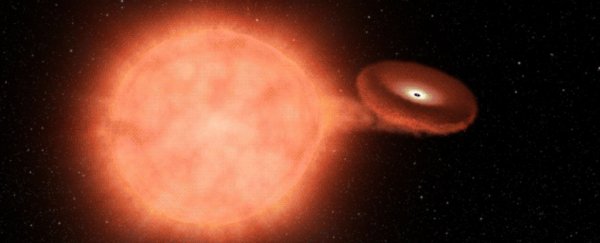Astronomers have been able to get their closest, most detailed look yet at the first stages of a dying star – a supernova known as SN 2018oh – using a combination of super-powerful telescopes out in space and based here on Earth.
This unprecedented look at the death throes of SN 2018oh (also labelled ASASSN-18bt), around 170 million years after the actual event, could teach us more about the fundamentals of how stars explode at the end of their lives - and help astronomers refine their models of the cosmos.
Part of the crucial observational data was logged by the Kepler Space Telescope just before it ran out of power and was officially put to sleep by NASA – showing that the deep space probe was proving useful right up until the end of its life.
"Kepler – in its final days before running out of fuel and being retired – observed the minute changes in brightness of the star's explosion from its very beginnings, while the ground-based telescopes detected changes in colour and the atomic make-up of this dying star," says one of the huge team of researchers involved in the work, astronomer Brad Tucker from the Australian National University (ANU).
"With the combined data from these telescopes, astronomers achieved what they had hoped for – an unprecedented observation of the onset of a star's death."
SN 2018oh is a Type Ia supernova, which means it is a dying binary star system where at least one of the stars is a white dwarf, one of the densest forms of matter. Astronomers use these types of supernovae to measure the expansion of the Universe and to investigate dark energy, so it's important to learn as much about them as we can.
We know how bright these stars should be when they explode at the end of their lives, which means we can calculate how far away they are, and from there - how quickly the Universe is growing.
But even though Type Ia supernovae are such a fixture in our toolkit for exploring the Universe, astronomers still don't precisely know the makeup of these systems.
These binary systems could involve two white dwarf stars coming to a spectacular end in a massive collision. Or it could be that these supernovae are caused by a single white dwarf star sucking up so much matter from a smaller star that it collapses in on itself.
This latest research brings us a little closer to solving that mystery. The teams noted that this particular supernova brightened very rapidly after its initial explosion, reaching billions of degrees in temperature in the space of just a few days rather than several weeks, as we'd usually expect.
"Many supernovae show a gradual increase in the light they put out," says astronomer Maria Drout from the Carnegie Institution for Science and the University of Toronto.
"But for this event, you could clearly see there's something unusual and exciting happening in the early times - an unexpected additional emission."
That unexpected observation could point towards one fat white dwarf having an extremely violent rupture that destroyed its binary companion.
"It's possible in the case of SN 2018oh that the shock wave from the exploding white dwarf ran into the companion star, creating an extremely hot and bright halo that accounts for the added brightness and heat we observed," says Tucker.
But not everyone involved in this research thinks it's a clear-cut case.
Astronomers have gathered so much detail on SN 2018oh, that an overall team of 130 scientists produced three separate studies outlining their findings, describing more detail on a supernova event than we've ever had on our hands before.
Despite the unprecedented detail, alas this is not the research that will end the debate over the precise makeup of the binary systems involved in Type Ia supernovae.
Some of the researchers have proposed that the additional heat and light may have been caused by an unusual buildup of radioactive nickel in the outer layers of two colliding white dwarfs - hence we still can't rule out either type of star system as the source of these magnificent events.
But because this was such an unusual and exciting supernova to train our instruments on, it's a huge step towards figuring out a lot more about this important type of stellar event.
"Nature is always finding new ways to surprise us, and unique observations like this are great for motivating creative new approaches to how we think about these explosions," said astronomer Anthony Piro from Carnegie Observatories.
And Kepler can enjoy its retirement out in the far reaches of space knowing that it gave one last present to astronomers.
Hopefully, the supernova data amassed in recent years will allow researchers to tweak their cosmological models to chart the Universe's expansion - if Type Ia supernovae are produced by a single-white-dwarf-and-something-else system, the next step will be to nail down the frequency of these events.
Three papers on the research have been published in Astrophysical Journal Letters and The Astrophysical Journal. You can view them online here, here, and here.
